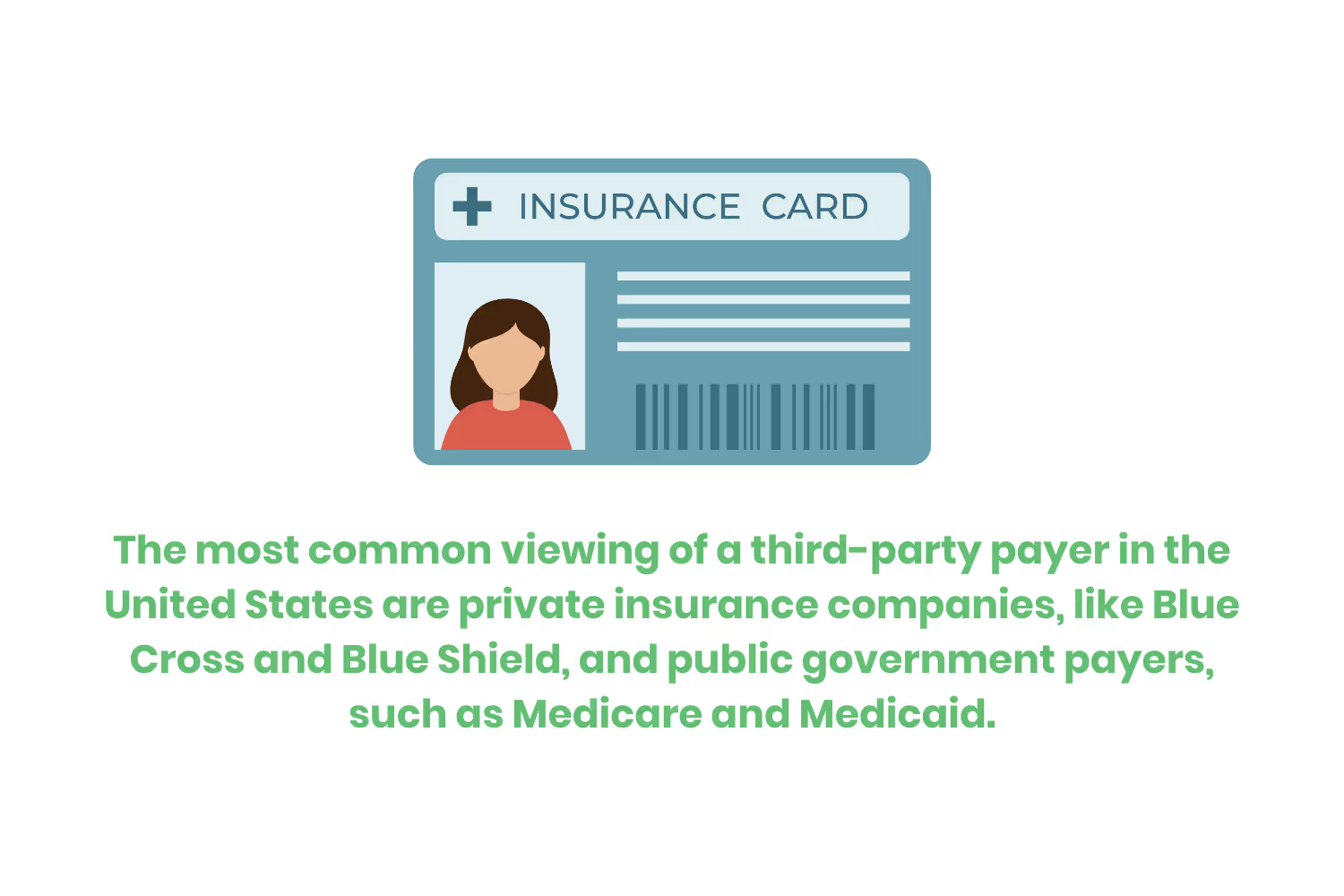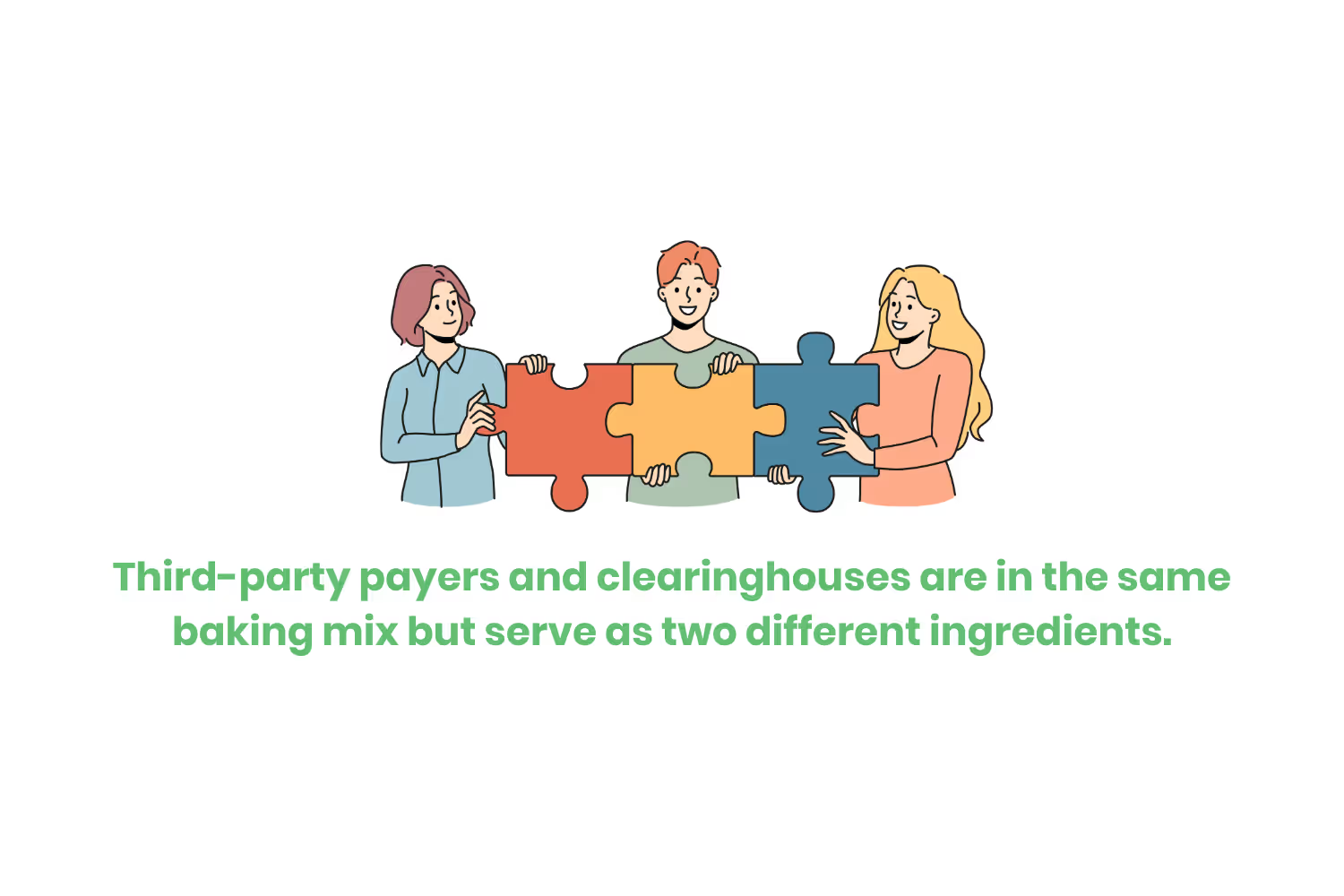[ANSWERED] What is Third Party Payment in Healthcare?v
Let’s answer the ever-popular question, “What is third-party payment in healthcare?”

I recently entered a job that revolves around the healthcare industry. More specifically, medical billing.
When I say recently…it’s been about 8 months. Depending on your outlook on life, whether you’re more of a glass-half-empty or glass-half-full kind of person, this can be a long time or a short time.
My point in beginning with this is that I write weekly blogs about healthcare and human resources and I STILL find myself getting pretty confused on all the different components that come into play with medical billing.
It’s part of my job responsibilities to be aware of this information. It can be a lot to keep up with. I can’t imagine how healthcare professionals can keep up with it all on top of their day-to-day responsibilities.
There are many revolving factors in revenue cycle management. Medical billing is part of the process that gets healthcare professionals paid. Both are quite an important subject if you ask me.

Imagine you’re a doctor and you have a patient that comes in for a service such as a check-up. After their check-up, there’s a cost associated with the services provided by the healthcare professional. It’s not as simple as paying for a haircut or covering the bill at a restaurant.
The reality is that medical billing can be a rocky process. On top of that, healthcare costs are quite expensive. This is why a lot of people have health insurance. For a majority of those people who don’t have health insurance for whatever reason, there are other options available to them which we will discuss in just a bit.
What’s insurance? Having insurance protects patients and their families from facing a financial crisis. It’s no surprise that life can get pretty hectic. You can’t foresee what it may throw at you. That’s why there are all different types of insurance. Life insurance, car insurance, health insurance, and so on.
Stay with me here. I promise this all correlates! Health insurance providers are third-party payment providers as well.
Third-Party Payers
A common term regarding medical billing is a third-party payer. Just as insurance looks like a lot of different things, a third-party payer can look like a lot of different things.
The most common viewing of a third-party payer in the United States are private insurance companies, like Blue Cross and Blue Shield, and public government payers, such as Medicare and Medicaid.
Back to the basics. Let’s brush up on a few definitions.
What is Medicare? Medicare is federal health insurance available to those who are 65 years of age or older. It’s also available to those under the age of 65 with certain disabilities or other medical diagnoses or conditions.
What is Medicaid? Medicaid is another federal organization that provides health coverage to people with low income or a lack of access to resources. This includes low-income adults, pregnant women, elderly adults, and people with disabilities. Medicaid packages vary from state to state. It’s a joint payment from the federal government and the dependent state.
In 2016, 28.6 million people did not have health coverage. Around 62% of these individuals qualified for a Medicaid package of some sort.
The number of people enrolled in Medicare as of March of 2023 is 65,748,279 people. This is an increase of about 100,000 people since September.
A third-party payer is any organization besides the patient that pays for healthcare services. They hold the responsibility of paying for the service provided on behalf of the patient.
Essentially third-party payers reimburse healthcare organizations. They’re a major source of revenue for most providers.
From these numbers, we can see that third-parties are widely used. Thus it’s important to know how to handle them.

Working alongside insurance on behalf of your patients is one of the core and basic tenets of the business of healthcare. You must incorporate time and effort to understand how it works. If you’re still reading this, that shows that you’re off to a great start!
Not all expectations from third-party payers are the same. You have to understand their policies and procedures to avoid any obstacles that could potentially stand in the way of your reimbursements. It’s a group effort. Your team has to be aware of this as well.
Besides private and public insurers such as insurance companies and government programs, there are a few other organizations that fall under the classification of a third-party provider.
Here’s what it can look like worker’s compensation, managed care organizations, and veterans affairs. It can also be an employer that is under a self-insured plan.
Self-insured health plans are most popular with large employers, labor unions, school districts, and other municipalities. Their process establishes a pool of money that gets distributed to employees for their healthcare services.
Regardless of what the organization looks like, the main goal of the third-party payer is to do just that. Pay up! This is not all they do. Not even close.
Third-party payers manage practically all the financial aspects of healthcare. This includes processing claims, facilitating financial transactions, and negotiating with healthcare providers to determine reimbursement rates and contracts for services. They also set forth the guidelines for coverage about services as well as medications.
So in summary, third-party payers do just about everything under the sun.
It becomes even more complicated when you throw in the fact that each insurer has its own set of conditions and expectations that a payer must be aware of to meet the standard to receive payment. It’s necessary.
What's a Clearinghouse?
When I first did research and reading on this topic, things got a little confusing. It’s not easy differentiating what a third-party payer was and a clearinghouse.
It can get a bit tricky. Third-party payers and clearinghouses are in the same baking mix but serve as two different ingredients.
A third-party payer is different from a clearinghouse. They have different responsibilities and serve different functions.
What is a clearinghouse? A clearinghouse, such as Etactics, exist as an intermediary. An intermediary facilitates the electronic exchange of healthcare information between healthcare providers and third-party payers.

I’m a visual person. If I could paint a picture of what this looks like for you, a clearinghouse bridges the gap between healthcare providers and third-party payers.
Their purpose is to ensure accurate and efficient submission of healthcare claims.
A clearinghouse validates the format of claims according to industry standards, checks for errors, and then sends the claims to the appropriate third-party payer.
Once the third-party payer receives the claims they can then process those claims.
Clearinghouses play a crucial role in the revenue cycle management process. Streamline the claims submission and reimbursement process, reducing administrative burdens for healthcare providers and improving overall efficiency.
Self-Payment

You may be thinking, what about the individuals that do not use a third-party payer? They’re called self-pay patients. They take on the full financial responsibility for their medical expenses.
This means that they pay the FULL cost of their healthcare services out of pocket. For this reason, it’s common for self-payers to negotiate payment plans directly with their healthcare providers.
Some seek eligibility for financial assistance programs offered by hospitals or other organizations.
All good information to know! It’s important to be aware of the different types of payers and how they operate their payment plans.
Types of Insurance
Depending on the insurance, there are certain guidelines policyholders must follow. It all depends on what the patient is looking for regarding healthcare services.
Are there more service options? More savings and better partnerships? Let’s review some of them.
Indemnity Policies or Traditional Fee-for-Service Insurance
These types of policies allow patients a broad selection of doctors and healthcare services to choose from when seeking out healthcare services. They can pretty much select any doctor or hospital they please. It doesn’t matter their location. With a fee-for-service model, each service gets billed separately from one another.
Preferred Provider Organizations
With PPOs, insurance will create a list of contracted healthcare professionals for policyholders to choose from. The patient receives the highest monetary benefit when choosing a healthcare provider from this list because of the partnership; however, they can choose to seek out services from other providers not on the list.
Health Maintenance Organizations
HMOs require their members to receive health care services from doctors and hospitals affiliated with the organization. The HMO will select a primary care physician who then treats and refers patients to other specialists within the HMO network when necessary.

Exclusive Provider Organizations
Similarly to PPOs, an EPO provides a list of local contracted, preferred providers a patient can choose from. The patient is ONLY covered by the plan if they seek treatment from a preferred provider on the list. They cannot look elsewhere or they will not receive coverage.
High-Deductible Health Plan
A high-deductible plan has a higher deductible than a traditional health plan. They’re seen as a benefit due to their low premiums.
Consolidated Omnibus Budget Reconciliation Act (COBRA)
COBRA is a federal law put in place to protect patient health insurance. If a patient experiences a situation such as termination of employment or a reduction of hours, the law extends the patient’s current group health insurance plan for 18 months. Depending on the situation, this period may be longer.
Conclusion
I hope you were able to take away some key points about third-party payers from this blog post. Third-party payers are quite a relevant topic in revenue cycle management. They play a huge role in making sure healthcare professionals receive payment.
To put it simply, a third-party payer is any organization outside of the patient that is responsible for paying the patient’s healthcare services.
Depending on the insurance provider, there are certain regulations and procedures that a payer must follow to receive payment. There are different insurance plans as well as types of payers.
Third-party payers are different from clearinghouses and self-payers. Both play a role in the revenue cycle management.
All of this is important information to be aware of for healthcare organizations to ensure a successful and healthy functioning practice.
Emphasize your product's unique features or benefits to differentiate it from competitors
In nec dictum adipiscing pharetra enim etiam scelerisque dolor purus ipsum egestas cursus vulputate arcu egestas ut eu sed mollis consectetur mattis pharetra curabitur et maecenas in mattis fames consectetur ipsum quis risus mauris aliquam ornare nisl purus at ipsum nulla accumsan consectetur vestibulum suspendisse aliquam condimentum scelerisque lacinia pellentesque vestibulum condimentum turpis ligula pharetra dictum sapien facilisis sapien at sagittis et cursus congue.
- Pharetra curabitur et maecenas in mattis fames consectetur ipsum quis risus.
- Justo urna nisi auctor consequat consectetur dolor lectus blandit.
- Eget egestas volutpat lacinia vestibulum vitae mattis hendrerit.
- Ornare elit odio tellus orci bibendum dictum id sem congue enim amet diam.
Incorporate statistics or specific numbers to highlight the effectiveness or popularity of your offering
Convallis pellentesque ullamcorper sapien sed tristique fermentum proin amet quam tincidunt feugiat vitae neque quisque odio ut pellentesque ac mauris eget lectus. Pretium arcu turpis lacus sapien sit at eu sapien duis magna nunc nibh nam non ut nibh ultrices ultrices elementum egestas enim nisl sed cursus pellentesque sit dignissim enim euismod sit et convallis sed pelis viverra quam at nisl sit pharetra enim nisl nec vestibulum posuere in volutpat sed blandit neque risus.

Use time-sensitive language to encourage immediate action, such as "Limited Time Offer
Feugiat vitae neque quisque odio ut pellentesque ac mauris eget lectus. Pretium arcu turpis lacus sapien sit at eu sapien duis magna nunc nibh nam non ut nibh ultrices ultrices elementum egestas enim nisl sed cursus pellentesque sit dignissim enim euismod sit et convallis sed pelis viverra quam at nisl sit pharetra enim nisl nec vestibulum posuere in volutpat sed blandit neque risus.
- Pharetra curabitur et maecenas in mattis fames consectetur ipsum quis risus.
- Justo urna nisi auctor consequat consectetur dolor lectus blandit.
- Eget egestas volutpat lacinia vestibulum vitae mattis hendrerit.
- Ornare elit odio tellus orci bibendum dictum id sem congue enim amet diam.
Address customer pain points directly by showing how your product solves their problems
Feugiat vitae neque quisque odio ut pellentesque ac mauris eget lectus. Pretium arcu turpis lacus sapien sit at eu sapien duis magna nunc nibh nam non ut nibh ultrices ultrices elementum egestas enim nisl sed cursus pellentesque sit dignissim enim euismod sit et convallis sed pelis viverra quam at nisl sit pharetra enim nisl nec vestibulum posuere in volutpat sed blandit neque risus.
Vel etiam vel amet aenean eget in habitasse nunc duis tellus sem turpis risus aliquam ac volutpat tellus eu faucibus ullamcorper.
Tailor titles to your ideal customer segment using phrases like "Designed for Busy Professionals
Sed pretium id nibh id sit felis vitae volutpat volutpat adipiscing at sodales neque lectus mi phasellus commodo at elit suspendisse ornare faucibus lectus purus viverra in nec aliquet commodo et sed sed nisi tempor mi pellentesque arcu viverra pretium duis enim vulputate dignissim etiam ultrices vitae neque urna proin nibh diam turpis augue lacus.




